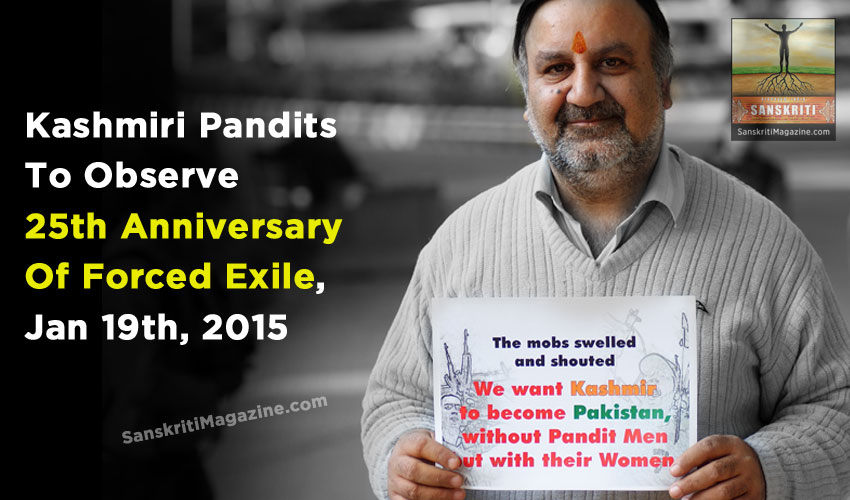– By Meenakshi Raina
The valley of Kashmir, surrounded by the vast Himalayan range has been a place of saints, sages and scholars. Kashmiri Pandits are the descendants of Rishis (sages) and have inherited the traits of great intellect and spirituality from them. They are the aboriginal people of the Kashmir Valley and are models of simplicity, purity, non-violence and compassion. Kashmiri Pandits (KPs) – the Hindus of Kashmir with a recorded history of over five thousand years have lived uninterruptedly in Kashmir since the dawn of civilization, till the Muslim invasions started.
Going back in the historical archives, Kashmiri Pandits (Hindus) have suffered at the hands of invaders and rulers from the alien lands. It was at the beginning of 14th century that the Muslim ruler Shah Mir introduced Kashmir to the religion of Islam through war and conflict, and the people of Kashmir could no longer live in peace. He let Islam set deep roots in the Kashmiri soil by subjecting Kashmiri Hindus to brutal persecution and forcible conversion to Islam. The persecution of Kashmiri Hindus continued during the Mughal and the Afghan rulers. Afghans brought Kashmir under their control by 1753 A.D. Their barbarity and brutality made life unbearable for the native Kashmiri Pandits. During their rule, thousands were killed and several thousands were converted to Islam. Many fled their homeland to escape forcible conversion. Over the centuries, due to countless invasions the culture and heritage of Kashmiri Pandits has been wiped out. History bears testimony to the fact that since the advent of Muslim rule till today Kashmiri Pandits – the aboriginal people of Kashmir have been the worst victims of Jihad. Their ethnic cleansing and genocide dates back to the 14th century and as a result of continual religious persecution Pandits’ population has considerably declined.
Kashmiri Pandits – infinitely tolerant and liberal towards people of other faiths, tried their best to co-exist with Muslims, but in 1989-90 due to terrorism, there came an end to the peace and harmony in Kashmir. The separatist movement in Kashmir started with the anti-India slogans, hoisting of green flags, the pro-Pakistani sentiments and the exploitation of the youth by the fundamentalist leaders, and the support from the radical Muslim population. Mosques meant for religious prayers were used to hide arms and ammunition. There was a well-planned strategy that started with selective killings of prominent Kashmiri Pandits to create fear and followed by brutal mass killings. The women were stripped and molested. There was a rise in kidnappings and merciless killings. The bodies of kidnapped and murdered Pandits bore the marks of torture, burn injuries, hangings and mutilation. Threatening letters asking Kashmiri Pandits to leave Kashmir (and leave their womenfolk behind) were pasted on their doors. Given the threat majority of the Pandit community left their land of ancestors and took refuge outside Kashmir.
Temples – the Hindu places of worship which testify the ancient history were vandalised, destroyed, demolished and set on fire. Leaving behind their property in Kashmir and deprived of their assets, Kashmiri Pandits were rendered homeless. They were the representatives of India in Kashmir and by hounding them the separatists tried to achieve the Islamization of Kashmir that would facilitate the implementation of their ideology. What was thought to be a temporary displacement, eventually turned out to be permanent. The properties of Kashmiri Pandits were forcibly encroached thus making their return to Kashmir impossible.
Recently, a similar genocide was faced by the Yazidis of Iraq. Our hearts bleed when we read about their tragic stories or watch their horrific journey in the news. It is an identical situation that Kashmiri Pandits faced 25-years back. While the Yazidi displacement is front page story; the world still doesn’t know much about the unfortunate mass exodus of Kashmiri Pandits. Not much global attention was received at that time and the voices of the displaced community remained suppressed. Their plight went unheard and they were abandoned and forgotten by the world. Thousands were massacred and around a half-million Kashmiri Pandits got uprooted from their land of ancestors. For many years the Pandit community had to live in tents and had to struggle for the basic necessities for life and even now after 25-years of forced exile their safe return to their homeland – Kashmir, is still doubtful. January 19, is observed as ‘Holocaust Day’ by the Kashmiri Pandit community globally. It was on January 19, 1990; Kashmiri Pandits were targeted and were forced to leave their homeland.
Today, the world is facing the threat from Jihad whereas Kashmiri Pandits have been its victim over past 25-years and they are refugees in their own country. When the symptoms of a disease are ignored for a long time, the disease takes the control. The 9/11 World trade centre tragedy, Mumbai blasts, Boston bombings, the ethnic cleansing in the Middle East, the barbaric practice of beheading and the recent attack on Canada’s Parliament are the manifestation of the same ideology of Jihad. It is the time for peace loving nations and moderate Muslims globally to step forward and take drastic actions to curb the roots of this menace











